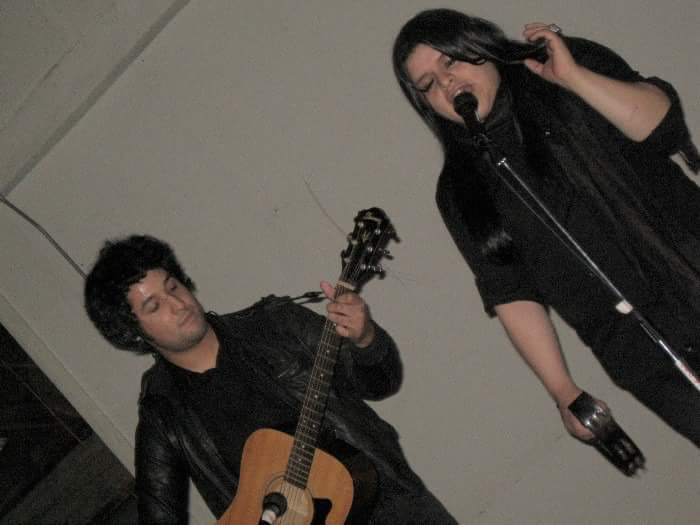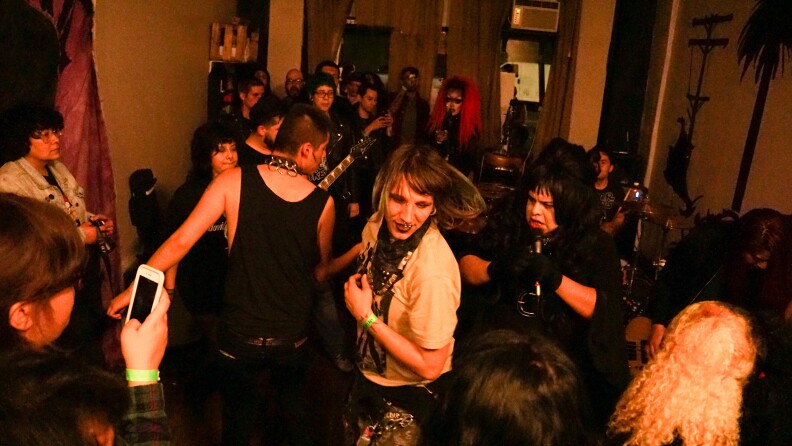Growing up, Drew Arriola-Sands' music was "too weird for the weird kids." Her first band couldn't even get a backyard gig, but since Sands transitioned in 2013, her current band, Trap Girl, have been at the center of an exploding queer hardcore scene in Los Angeles.
NOTE: Trans Pride L.A. is taking place this weekend, Saturday June 17, at the Los Angeles LGBT Center. To hear a preview of the event with organizer Gina Bigham, listen to the extra audio on this post.
Sands is 28 now, but she's always been drawn to glamorous women with big hair. Her mirror is adorned with pictures of Ronnie Spector, Dolly Parton, and Jayne Mansfield. Wig idols, she calls them. Sands has a large collection of wigs, and even makes her own, but it all started 20 years ago.
"When I was a little kid, my mom always had short black hair," Sands remembers. "And then one day, getting ready for school, she walked out of the bathroom with a long, thick, black braid with a ribbon on it, and it freaked me out, because I never saw her with long hair. So I was like, 'That’s weird! What is it?'" She was eight years old. For weeks to come, Sands would lock herself in the bathroom and stare at the extension braid in it's clear, Avon box until her mother threw it away without warning. The seed had been planted, though.

Her love of singing came at an early age too. As a child, Sands would stand up on a chair while watching baseball with her father to sing the national anthem. Her mother would scold her for being loud and tell her that she could sing at a baseball game when she was older. At 11, her father put her in little league.
We look at a picture of young Drew in a baseball jersey. Sands was a chubby little kid, biting down a smile, and burying her hand in her mitt. "I was a 'catcher' even then," laughs Sands.

"I was told I was gay before I even knew I was gay, because people saw I was feminine, did things a little different, spoke a little different, a little more sensitive," says Sands. Bullying was a consistent part of her childhood, with no one incident standing out because there was always "80 more horrible ones," she says. But she found ways to cope through her hobbies.
Her father said if she wasn't going to play a sport, she had to play an instrument. The first instrument she started with in earnest was the guitar, before picking up bass and more. "Nirvana was still the biggest band in the world. Everyone at my junior high who played guitar learned how to play 'Rape Me' or 'Smells like Teen Spirit' as their first song" says Sands. The first song sands learned on guitar was Nirvana's "About a Girl," and the first album she bought was Hole's "Live Through This."
"One of my first jobs, actually, was making burnt cd’s for a guy who sold them at the alley, and he made me copy Trina cd’s, ten at a time. She had songs on there like 'Nasty Bitch,' things like that, and I just loved it! But it was like a guilty pleasure, 'cause I was still a rock kid." - Drew Arriola-Sands

By her early twenties, she started her first real band, The Glitter Path; Sands describes it as something like Daniel Johnston, the schizophrenic outsider musician, mixed with Patsy Cline - extremely emotional, "lying across the road, ready to die type of music." It didn't fit in in the "very straight, very cis, surf rock-indie" backyard scene, says Sands. She can't remember the band playing more than two or three shows, anywhere, but she says she doesn't hold any grudges.
The Glitter Path's "Wear a Wig"
We look at another photo of Sands from her Glitter Path days. She points out the increasing number of women’s accessories she was wearing at the time. She was starting to feel a change coming.
"I was in a relationship in 2013 with an artist, but I was male presenting, and I had these feelings of identity and gender, and I expressed them to him, and he accepted them," Sands says, "but didn’t know how to deal with me and I didn’t know how to deal with myself." Sands boyfriend broke up with her, and she reevaluated her emotional state. "My mental health was not going to get better if I did not come out [as a trans person]," she decided.
She had a much easier time dating after transitioning, and one chance hook-up set Sands down a new musical road.
"So this guy I was hooking up with at the time would play the Damned in the room while we were hooking up. I had a guitar in the room, and he didn’t know I played music and said, 'Do you play guitar?' I said, 'Yeah.' He said, 'Well, you should start a band, like the Damned, and play guitar. It’d be good, looking the way you do, and wear ball gowns.'” - Drew Arriola-Sands
Sands started Trap Girl, not as guitarist, but as lead singer, in 2014.
The early shows were backyard gigs in South Central. Songs like “Dead Men Don’t Rape” went over well, but Sands wasn’t out as a trans performer yet. Maybe people could read between the lines though, with a name like Trap Girl. Sands offers a few definitions for Trap Girls/Trap Queens (though she has never settled on just one).
- A woman who helps out a "trap lord," or drug dealer
- A very convincing transvestite
- A girl trapped in a man's body
Throughout 2015, Trap Girl built their following Downtown and on the Eastside, with Sands finally out as a trans artist.
Trap Girl live at Xicana PUNK Night
"I started this band alone," explains Sands. "I didn’t know any queer people, I didn’t know any trans people, I didn’t know who was gonna help this band. Who was gonna give us a shot? So, I was ready to defend this band, even though there was no one defend it from."
Rather, Trap Girl were embraced and found sisterhood in bands like Sister Mantos and Yaawn. In 2016, Sands took it a step further and organized the first annual Transgress Fest (at the Santa Ana LGBT Center), for trans performers. "We had people as young as twelve to people as old as sixty in the audience," she says. "We had a huge turnout. I never expected that."

Transgress Fest is coming back in November. In the meantime, Trap Girl are getting ready to release their second EP, "The Black Market." The title track grapples with the question of whether or not a trans person needs surgery.
"Being a woman doesn’t mean you have to look like a woman. I didn’t know any trans people at all before I transitioned, so automatically, my idea was to think that I needed to present as feminine to be accepted as a trans person, but little did I know, that that’s the last thing you need to be a trans person. Not all people can pass, and that’s ok." - Drew Arriola-Sands
Sands says the takeaway from "The Black Market" is not to risk your life with black market cosmetic procedures. "These girls are killing themselves to achieve their looks," says Sands. "They’re getting it offline [sic], off Craigslist. You know, they go to someone’s basement and get their ass injected with cement, and then they go home and get a blood clot in their lungs, and they die." "The Black Market" EP is due for release this summer.
Trap Girl is singer Drew Arriola-Sands, bassist Ibette Ortiz, drummer Jorge Reveles, and guitarist Estevan Moreno.






